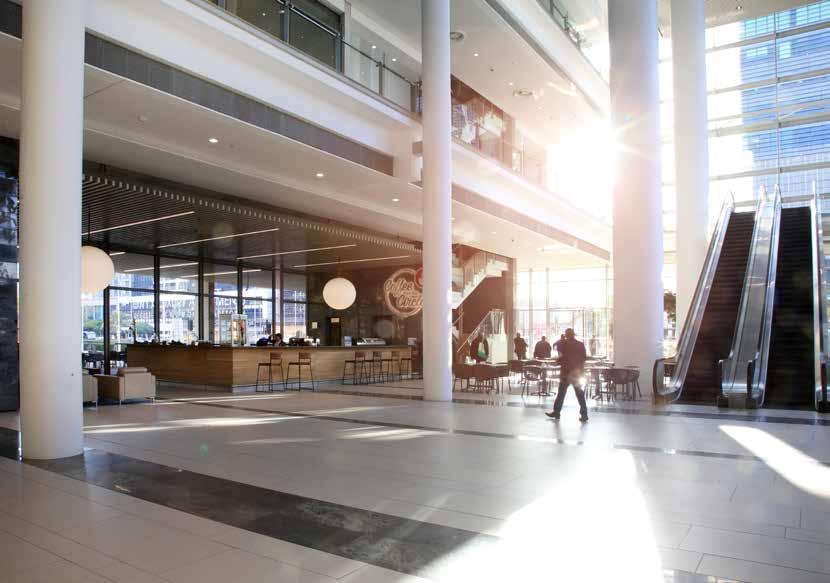
13 minute read
Houston, we have a problem
by 3S Media
During a crisis, effective communication can make the difference between being aboard a sinking ship or weathering the storm. In the wake of Covid-19, Meetings looks at just some of the considerations that conference and exhibition venues can include as part of their crisis and communication management.
Advertisement
Towards the middle of March, when it started becoming abundantly clear to South Africans and the world as a whole that we were facing our greatest challenge yet as a society, we saw a slew of Covid-19-related communication going out – from employers, clients and industry, to service providers and retailers across the board, everyone was issuing communication around the virus.
In the Good Practice Guidance on Convention and Exhibition Centre Health and Safety: Managing COVID-19 , issued on 24 March in collaboration between the International Association of Convention Centres (AIPC) and The Global Association of the Exhibition Industry (UFI), there are key recommendations that these types of venues in particular can follow to develop crisis and communication management plans. During an unforeseen disaster, this is essential to reassuring and updating staff, clients and other industry affiliates of the current status of any existing operation.
HAVING A POLICY, PLAN AND RESPONSE According to the AIPC’s and UFI’s Good Practice Guidance , it is advisable to, ahead

of time, have a policy and plan in place to manage any potential threat, with Covid-19 only serving to underscore the need for this.
The idea, says the document, is for organisations to have a policy, plan and a team, or taskforce, to carry this out and lead efforts in the event of a crisis: “A policy in its simplest form is a written statement outlining an organisation’s position or objective on a particular issue. Convention and exhibition centres, as do many other types of organisations, have standard policies on a range of matters, though many use terms other than the word ‘policy’. A plan is a written document outlining an organisation’s steps towards achieving the stated policy objective. It will usually encompass identification of who will lead the effort, who will perform the effort, and what the effort will consist of. In most plans, the ‘who’ and ‘what’ to achieve specific effects are further defined in procedures or protocols,” explains the guide.
Other plans that should be considered alongside a Covid-19 response plan are those that pertain to health and safety, business and activity continuity, crisis management and communication. Within this, certain procedures that could also be useful during times of crisis should be reviewed as part of an organisation’s larger plan. At an operational level, these procedures can include crisis management team activation, operating a first-aid or medical station, increased sanitisation and disinfectant regimes, means for screening, a space for temporary quarantining in case of a suspected outbreak, working with the authorities, managing internal and external communications.
For employees, crisis and communication measures should address a rapid facility shutdown, how employees are informed of the potential crisis, how they will be supported if they fall ill, as well as working from home and travelling for work.
CRISIS MANAGEMENT AND COMMUNICATION Crisis management and communication will go hand in hand. Communicating as much as possible with your staff and clients will give them reassurance of activity and business continuity, and this is particularly important during times of uncertainty.
“To manage emergencies, set up, equip, train and maintain a convention or exhibition
CRISIS COMMUNICATION LIFE CYCLE
Mix of information to communicate, by type, %
HOW TO… COMMUNICATE LIKE A LEADER
In April, McKinsey & Co. released a comprehensive guideline outlining five key areas of need within crisis communication during the Covid-19 pandemic.
Internalising
Adjusting
Instructing
1. GIVE PEOPLE WHAT THEY NEED,
WHEN THEY NEED IT Ensure that information provided enables people to act to stay safe, cope better mentally, and emphasise belonging to create a deeper sense of purpose and to bring stability to those who may need it.
Resolve
Employees are feeling
What they need
• Confused • Anxious
• Facts, not speculation • Clear instructions on how to protect their safety Resilience
Crisis stage
• Uneasy • Worn down
• Clarity on longerterm plans • Positive stories • Chances to connect
Return/ Reimagination/ Reform
• Ready for change • A sense of loss
• A new vision for the future • A chance to grieve
2. COMMUNICATE CLEARLY, SIMPLY,
centre Crisis Management Team (CMT). This would include a Crisis Management Plan and a properly equipped, designated CMT Crisis Room,” says the Good Practice Guidance.
Locally, in South Africa, the Disaster Management Act (No. 57 of 2002) is what current procedures and protocols are based on but some of the international standards that we can turn to are ISO 22301 (Business Continuity) and ISO 31000 (Organisational Resilience).
Ultimately, your CMT must be able to roll out your organisation’s crisis management processes and inform the communication that takes place around this, relying on credible and reliable resources to provide updates as there are growing developments.
Lastly, the experts advise that your CMT is not only proficient in being able to manage all crises but that they are able to roll out all relevant aspects of each communication plan in a professional manner. These plans also need to factor in that communication may need to be issued in various languages and across a range of platforms such as SMS, email and WhatsApp to ensure sufficient reach. Other suggestions in line with this include having a dedicated hotline and resources that affiliates and stakeholders can refer to, as well as prepared plans that can be updated where need be and implemented swiftly.
FREQUENTLY Absorbing information during times of crisis can be difficult for some; focus on the primary needs of your colleagues and clients and repeat your messaging often and across different platforms where it is required.
3. CHOOSE CANDOUR OVER CHARISMA Trust is critical during a crisis, so be transparent on where matters stand and don’t be afraid to show vulnerability. Be open, honest and consistent in your delivery to build loyalty and lead more effectively.
Whatever our plan is, the overarching sentiment seems to be that we cannot be without one.
For more information, visit themeetingsindustry.org, aipc.org or ufi.org.
4. BUILD RESILIENCE With the health crisis having a knock-on effect and now developing into an economic crisis, highlight the positive aspects within your network and strengthen collaborative efforts to bolster common objectives.
5. SEPARATE MEANING
FROM THE CHAOS Help people come to terms with where we find ourselves in the crisis and reassure them that ‘this too shall pass’ by working to have a clear way forward for how your organisation and its people will emerge.
CRISIS COMMUNICATION 101
By Projeni Pather, chairperson of AAXO
Communication is key during the next few months and is essential to maintain relationships with our employees, exhibitors, partners, stakeholders and suppliers. • During this time, take care of your staff. Ensure they understand everything about Covid-19, what the symptoms are, and the strict hygiene controls required. • Communicate your decisions with all stakeholders via online notifications,

press releases, email, SMS and follow up with a telephone call. • Monitor social media platforms, in case of questions or negative sentiment. • Publish contact details through which stakeholders can contact you for more information. • Make sure that your internal teams are fully aware of plans and procedures around postponement or cancellation and have a consistent message to all stakeholders.
Alan Hosking is the publisher of HR Future magazine, and an expert in preparing people and companies for the future of work. He advises Pippa Naude on how employers and employees can best navigate the challenging conversations that need to take place around Covid-19 and its impacts.

HR management in a time of crisis
Covid-19 has created a lot of uncertainty. How important do you think it is for companies to communicate with their staff about what is happening, even when they do not have any specific information to share?

AH While communication has always been important at the best of times, in times of uncertainty, it’s even more important for leaders to communicate proactively – and regularly – with their people.
An absence of communication causes employees to jump to their own conclusions and jump they do. That’s when the grapevines and rumour mills get out of hand and cause damage through misinformation and socalled fake news being spread as people are left to draw their own conclusions.
An absence of communication also triggers suspicion and mistrust. Prevention is better than cure, so companies should make a point of communicating with their people on a predictable basis and in a predictable way, as predictability engenders trust and security. If staff know when to expect communication from their leaders, and they receive it as and when expected, they feel that their leaders know what they’re doing and that things are under control. This results in a higher level of confidence and comfort – despite the general discomfort.

Jobs are on the line, and measures such as reduced hours are being introduced. There is obviously a lot of fear and anxiety about job losses. What advice would you give someone in terms of how to have conversations about this with their staff? Accept that, as a business owner or leader, you must have these conversations. Prepare for it so that you know what you need to say and why; then do so with courage and compassion. When the chips are down, people appreciate good, old-fashioned honesty. The circumstances that led to the need for the conversation were not the fault of anybody in the company, so be gentle, be kind and be practical. Don’t burn any bridges.
It’s also important to have developed a survival strategy that is fair to all. There’s nothing worse than being challenged on a decision and not being able to defend the decision in an objective way because it is not based on fair principles. Compassion is critically important. Some leaders think that compassion is a sign of weakness. It’s not – it’s a sign of emotional maturity. Approaching this conversation in a hard-hearted way because you feel uncomfortable about it is simply destructive and closes doors rather than leaving them open.
If there are implications in terms of the Labour Relations Act (No. 66 of 1995), it’s best to seek the advice of a legal practitioner who can advise you on the options available to
employer and employee, and on how to manage the process correctly so that there are no unpleasant comebacks simply because correct procedures weren’t followed.
What would you advise an employee in terms of how to broach a conversation with their boss if they are not being told anything right now? As any musician will tell you, timing is critical. You might know the right note to play but if you play it at the wrong time, it’s a disaster. If, as an employee, you want to get a considered and appropriate response from your boss, it’s best to wait for the right time to speak to them, and not catch them unawares or in the middle of something. It’s a good idea to ask them when a good time would be to chat to them. If they ask what it’s about, you





can simply say that there are a couple of uncertainties you would like clarified and wondered when they had a quiet moment for you to chat to them.
When you do have the conversation, try not to allow your emotions to get the better of you and become aggressive, as that won’t help the situation at all.
Are staff morale and well-being important at a time like this? And if so, do you have any simple suggestions on how they could be improved? Staff morale and well-being have never been more important. As people are being forced to work remotely, they are all going on a steep learning curve. Employees need to learn how to manage their time and workload while they also manage children’s homeschooling. Team leaders are having to learn how to keep in touch with staff who are not in the office. At a time like this, it’s easy for morale to plummet because of all the additional challenges and stress that goes with them.
Morale and well-being are determined by team leaders, so it’s vital that they make a point of projecting positive energy at a time like this. One of the ways is to welcome the remote working situation that has been forced on everyone, as it provides an opportunity for everyone to try it out.
Leaders need to send messages that build confidence in their

staff, display understanding when they receive complaints about how difficult it is, and offer what practical advice and support they can under the circumstances. Understand that, if an employee is expressing frustration that they can’t get their work done, there’s a good side to that – they actually want to get their work done! Recognise that for what it is and be their cheerleader during these uncomfortable times. Instil a confidence in their ability to cope and do what is required of them.
The Planner is growing its footprint – connect with us today!
theplanner.guru is a one-stop platform where you can read the hottest industry tips and trends as well as gain insight from valuable information in the MICE
Hub. This online mouthpiece of the industry reaches your target market, three times per week, through The Planner’s engaging online newsletters.




Packed with advice, handy tips, tools, and event planning insight from leading industry and event planning insight from leading industry experts and combined with the comprehensive experts and combined with the comprehensive listings, listings, The Meetings & Event Planner is The Meetings & Event Planner essential if you’re organising any type of event. essential if you’re organising any type of event. Published annually. Published annually. This alternative monthly publication investigates new trends, ideas and strategies relevant to the meetings and events industry to keep you ahead of the planner pack.
THE THE EXHIBITION INCENTIVEINCENTIVE Looking for new and exciting destinations? exciting destinations? The Incentive Planner is jam-packed with fresh The Incentive Planner is jam-packed with fresh ideas and top tips to turn any incentive trip into ideas and top tips to turn any incentive trip into a memorable experience. Out each year in September with Meetings.
The Exhibition Planner is an essential tool for exhibitors. Information is packaged in an easily digestible format addressing the entire process of planning and arranging a show stand, what to do pre-, during and post-show. Published annually.










